|
Living in Wolverhampton,
1862-1867
In
September 1862 George Macdonald and his family moved to
what turned out to be his final ministry in
Wolverhampton. With Georgiana married and Harry sailing
for New York in 1858 after failing his Oxford degree,
Alice (in her mid-20s), Agnes (late-teens), Louisa
(late-teens) and Edith (mid-teens) made the 120 mile
journey from the capital to south Staffordshire. They
lived in a large terraced house built around 1850 along
Waterloo Road, an affluent street laid-out in 1840 on
the western edge of the town. From the back of their
house there would have been views across the Racecourse
(now West Park) to open countryside.
Although
a growing industrial town, Wolverhampton in the 1860s
still maintained the look of the large market town it
had been in previous centuries. There were many
timber-framed buildings, typical of the vernacular style
found across the western Midlands, as well as fine
Georgian houses, of which Molineux and Giffard Houses
are notable survivors. |
|
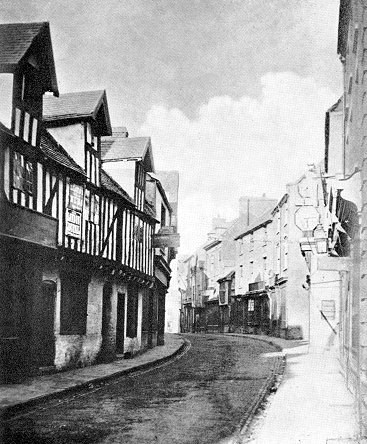
Lichfield
Street, Wolverhampton in 1870. |
The
photograph shows Lichfield Street as the Macdonalds
would have known it.
All of
these Mediaeval and Georgian buildings were swept away
in the 1880s when the street was widened and
reconstructed. |

View of Wolverhampton from the Racecourse, c.
mid 1860s.
| This photograph was taken when the Macdonalds were
living in Wolverhampton. Waterloo Road runs across the
middle of the photograph. The back of the Macdonalds
first home is on the right with a clearly projecting
3-storey side wing on the corner of Clarence Street
(star above). Their later home (arrow above) is on the
far left of the pale-coloured terrace in the middle of
the photograph, although it is mostly obscured by the
large gabled building, the new Baptist Church
constructed 1863-4. Although not easy to see, the latter
doesn't look complete, which helps to date the
photograph. |
| Most of this view would be recognisable to them,
including the Subscription Library on the left. Their
first house is just off the photograph to the left;
their later home is at the far end of the terrace to be
seen mid-way along on the right, opposite the new
Baptist Church with its distinctive tower.
A few hundred yards even further along was the end of
the large garden of Molineux House (still extant) which
is now occupied by Wolverhampton Wanderers Football
Club, founded a decade after the Macdonalds left the
town. |
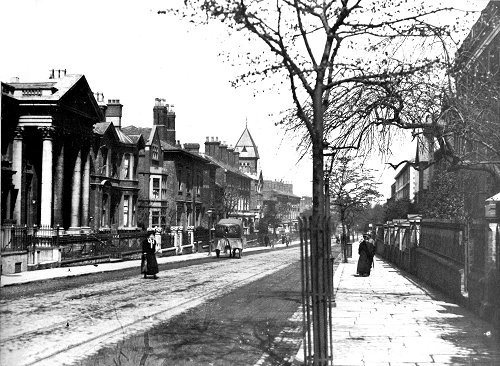
Waterloo Road almost 40 years
after the Macdonalds left. |
|

Map of Wolverhampton in 1871.
The map shows the narrow streets, some
of which were about to be widened, and the newly built
Town Hall. The Minister's house in Waterloo Road was
yards from the Methodist church in Darlington Street.
The present magnificent church with its prominent dome
was consecrated in 1901, replacing the building from
1825 where the Macdonalds worshipped. The school built
in 1857 behind the church is still extant. |
|
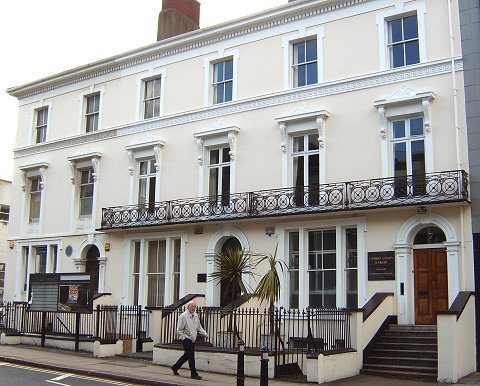
The Minister's home (on the far
left of the terrace) at 3, Waterloo Road. |
The Macdonalds lived there from September 1862 until
late 1863.
The blue plaque commemorating the sisters was erected
by Wolverhampton Civic Society, sponsored by the estate
agents then using the ground floor.
 |
| Darlington Street Methodist
Church (built 1825).
The tower of the school
buildings (still standing) is seen behind the church.
|
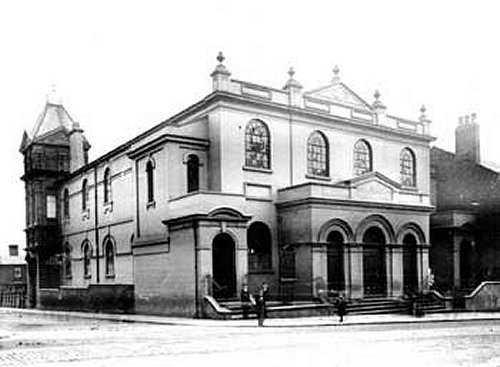 |
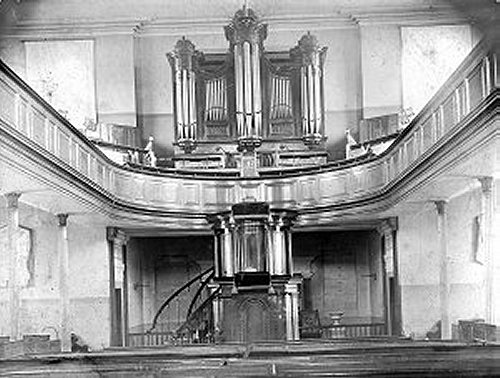 |
The interior of Darlington
Street Methodist Church in the 19th century.
This shows the pulpit where
George Macdonald would have preached. |
| At the same time as his family moved to
Wolverhampton, Fred, now 20, followed the family
tradition by becoming a Methodist preacher in Burslem,
one of the north Staffordshire Potteries towns. |
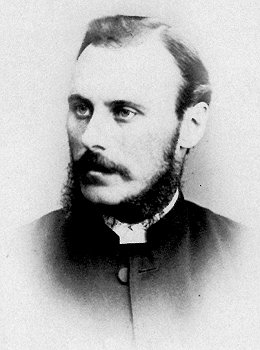
Rev'd Fred Macdonald, c.1862, aged
about 20. |
|
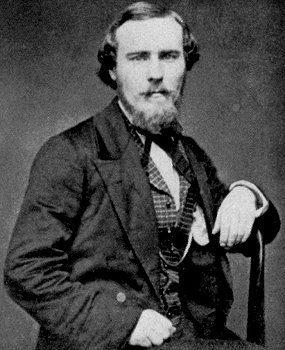
Harry Macdonald, c.1860, aged
about 25.
|
|
No doubt missing her
friends, Alice was soon back in London, staying with the
Burne-Jones’s between October 1862 and February 1863.
After a short time in Wolverhampton, from April 1863 she
visited her brother Fred in Burlsem for a month. Alice,
Fred and some of his friends, including John Lockwood
Kipling, ate a picnic at a local beauty spot, Rudyard
Lake near Leek. Alice is supposed to have first seen her
future husband, Kipling, while eating a spring onion!
J. L. Kipling was born
in Pickering, Yorkshire, the son of a Methodist
minister. He was working as a designer and modeller at
Pinder, Bourne and Co, a pottery firm in Burslem. Later,
he was later apprenticed to J. Birnie Philip, a London
sculptor, and then split his time between the capital
and Burslem. From May 1863 he was visiting Wolverhampton
to see Alice.
Although already unwell
when he arrived in Wolverhampton, George Macdonald had
increasing bouts of ill health (he had suffered from
severe back pain which made it difficult for him to walk
or sleep) and by the autumn of 1863 he was so ill that
it was decided he could not work again. To make way for
the new minister, the family had to move to a smaller
house across the street at 32, Waterloo Road. |
|
A short
distance from the Minister’s home, the house on the far
left of the terrace in the photograph opposite, is where the Macdonalds lived from
Autumn 1863 until 1867. Alice left to get married in
March 1865, followed by Agnes and Louisa in August 1866.
George’s illness must
have proved a difficult time for the family,
particularly from a financial point of view. At least
they had the support of the new friends they had made
locally.
Mrs Macdonald wrote: “I
am pleased with the people here both in the higher and
middle classes” after a day with the Hartley family at
Tong Castle, Shropshire, just 13 miles to the
north-west. Henry Hartley was a Methodist, an iron
master and Mayor of Wolverhampton. |
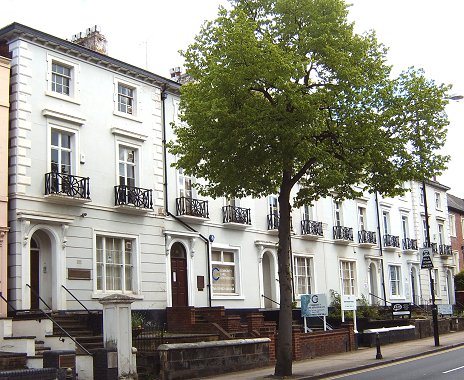
|
32, Waterloo
Road.
The Macdonalds moved here after living at 3, Waterloo
Road from September 1862 until late 1863. |
|
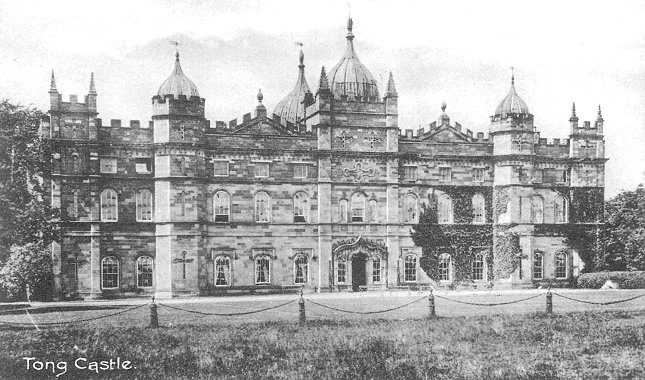
Tong Castle, Shropshire. Demolished 1954.
| Mrs Macdonald's diary entries refer to many dinners,
teas and outings, especially for Agnes and Louisa.
Louisa later wrote: "At that time our home life was
completely overshadowed by the long illnesses of our
father, and almost all the sunshine that came to my
sister and myself in those days we owed to the
affectionate kindness of Mr and Mrs Fowler". Henry
Hartley Fowler and his wife Ellen Thorneycroft were
relatives of the Hartley's. They lived near the
Macdonald's at Summerfield, Chapel Ash, opposite the
Racecourse. Fowler (whose father was a Methodist
minister) was a prominent local solicitor who later
became a councillor, Mayor, MP, Secretary of State for
India and the 1st Viscount Wolverhampton. His daughter
Ellen (born 1860) became a famous novelist in the 1890s. |
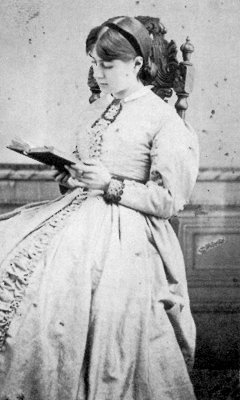
Louisa Macdonald aged 16. About a year before moving to Wolverhampton. |
|
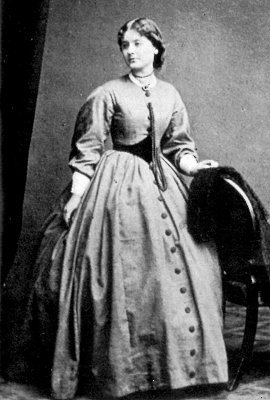
Agnes Macdonald in 1865, aged
22. Shortly before her engagement. |
The Macdonald family was plagued by illness during
1863-4. In 1863 Louisa had contracted smallpox during a
summer stay in London; Alice travelled south to look
after her, taking her onto Ramsgate for a month to
recover. In the Spring of 1864 the infant Philip
Burne-Jones and his mother Georgiana went down with
scarlet fever. This was catastrophic for Georgiana as
she was pregnant at the time. Her son, Christopher, was
born prematurely as a result of the illness and died
after three weeks. This tragedy had further
implications. Recuperating at Hastings, Georgiana did
not want to return to the London house which held such
painful memories. As Burne-Jones had not worked for 4
months and there were expensive doctors bills to pay,
money was short, so plans to extend Red House for the
Burne-Jones's to live adjacent to the Morris's were
dropped. (Reluctantly, in 1865, Morris sold Red House
and moved back into central London).
Over Christmas 1864, Georgiana and Philip stayed in
Wolverhampton while Edward Burne-Jones was house-hunting
in London. They returned to London in January 1865 after
a three year lease on a house in Kensington Square was
secured.
In the early 1860s the Macdonald sisters had enjoyed
happy times at Red House, often visiting when they lived
in London and continuing to visit when they lived in
Wolverhampton. William Morris enjoyed their company and
gave encouragement to their artistic efforts, being
impressed by one of Louisa's wood engravings (she later
enrolled at Wolverhampton School of Art). He was always
keen to see Agnes as he commented that no-one else could
tell such entertaining stories as her. Georgiana was to
become one of his closest friends. On a visit during the
Spring of 1864, Louisa, Agnes, Georgiana and Jane Morris
were recorded in Burne-Jones's watercolour 'Green
Summer', set in the garden of Red House. |
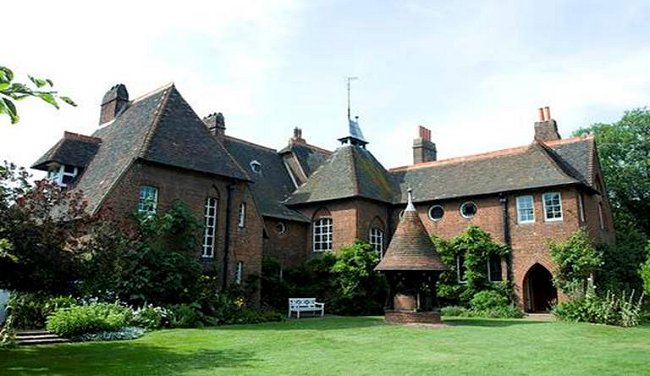
Red House, Bexleyheath. William Morris's home
from 1860-65. Now in the care of the National Trust.
 |
|
Green Summer by Burne-Jones, 1864. |
| Jane Morris is in
the centre holding peacock feathers, to her
left is probably Agnes. Georgiana is shown
reading, and to her right is most likely
Louisa. Burne-Jones was inspired by the
sisters rather than representing them
accurately. |
|
In January 1865 John Lockwood Kipling signed a three
year contract as Architectural Sculptor and Professor of
Modelling at the School of Art and Industry in Bombay,
precipitating his wedding to Alice. Her father's illness
meant that the wedding could not be held at home
(Wolverhampton) and so Georgiana organised it in London
for the 18th March 1865. The Kiplings made a short visit
to Wolverhampton before embarking on SS Ripon for Egypt
and India. On 31st December 1865 Joseph Rudyard Kipling
was born to Alice. Louisa is said to have suggested his
middle name to commemorate his parents first meeting at
the lake of that name in north Staffordshire.
Within a matter of months there were three more
Macdonald engagements. In March 1865, when Agnes was
staying with the Burne-Jones's helping to arrange
Alice's wedding, she first met her host's friend Edward
Poynter.
Poynter had already exhibited paintings at the Royal
Academy. He had studied in Rome and Paris where he
became friends with Frederick Leighton, Whistler,
Alexander (Alecco) Ionidies and George Du Maurier. Du
Maurier was an artist and Punch cartoonist (from 1865)
who married Emma Wightwick. He was the father of the
actor Gerald and grandfather of the writer Daphne. Agnes
and Poynter were soon engaged (April 1865), not long
after brother Fred's betrothal to the daughter of a
pottery manufacturer in Burslem.
Louisa was to follow a few months later by becoming
engaged to Alfred Baldwin in October 1865. She had only
met him the previous August during a holiday with the
Baldwins in Stourport, Worcestershire. Mrs Macdonald was
unhappy with Louisa's choice as she thought Baldwin was
pompous and arrogant, but at least he was wealthy,
unlike the other son-in-laws. Alfred Baldwin's
grandfather (an iron founder) had moved to Stourport in
1788 after the Staffordshire and Worcestershire canal
had reached the Severn. Alfred's father died before he
was born, so on his majority he inherited his father's
share of the family business E. P. & W. Baldwin, which
from 1854 was based at nearby Wilden where there was an
iron and tin plate works. The business also included a
tinplate works in Wolverhampton as well as the foundry
in Stourport.
There were now three imminent weddings! Poynter and
Baldwin made a number of visits to see their prospective
brides and in-laws in Wolverhampton. The wedding
originally arranged for Agnes and Poynter on the 9th
August 1866 became a double ceremony with Louisa and
Baldwin also marrying at the same time. The weddings
took place in St. Peter's Collegiate Church,
Wolverhampton, where, because of their father's poor
health, the brides were given away by their brother
Fred. |
|
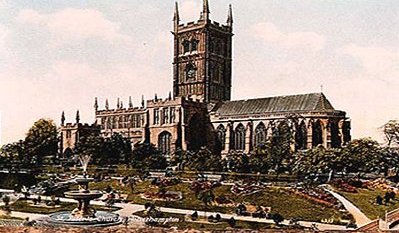
St. Peter's Collegiate Church in
the late 19th century. A mainly 15th century church of
Saxon foundation, the chancel (to the right) had been
rebuilt in 1865. |
After the ceremony, Fred rushed off to Burslem to
get married the next day (presumably with few, if any,
of his family present). Alice was still in India and the
Burne-Jones's decided at the last minute they couldn't
manage the trip to Wolverhampton. Georgiana had given
birth to Margaret weeks before, yet had been able to get
to Hampshire instead! Had there had been an estrangement
between the siblings or had circumstances simply
intervened?
After their honeymoon the Poynters settled at 106,
Gower Street, London. Ambrose Poynter was born to Agnes
on the 26th September 1867. |
Although Louisa wanted to set-up home in
Wolverhampton, unsurprisingly, the Baldwins went to live
in Bewdley, close to Stourport and Alfred's business.
Stanley Baldwin was born to Louisa on 3rd August 1867.
Edith Macdonald never married and like many youngest
daughters at the time was probably expected to look
after her parents.
In early 1867 Louisa finally persuaded George and Hannah
Macdonald to leave Wolverhampton to be closer to her in
Bewdley. They found a house a few doors along the High
Street from their daughter. George Macdonald died in
1868, Hannah surviving him until 1875. |
 |
|
 |
|
 |
Return to
Early Years |
|
Return to
the beginning |
|
Proceed to
Queen Victoria's Visit |
|